A Starry Night Sky And And An Atmospheric Glow Blanket The Well-lit Southeastern African Coast As The

A starry night sky and and an atmospheric glow blanket the well-lit southeastern African coast as the International Space Station orbited 263 miles above, July 2021 (NASA)
More Posts from Starry-shores and Others
It makes me sad how no one ever seems to mention how wild the crocodilian-line archosaurs were. Dinosaurs get all the attention when there was equally crazy shit happening on the other branch of the archosaur tree.
There was a whole linage of bipedal crocodylomorphs during the Triassic that were basically identical to theropod dinosaurs, so much so that a lot of them were initially classified as dinosaurs!



Just fucking look at them!
And these weren’t just little lizard guys, there were some big lads running around.


Not to mention the long-legged ones that galloped around on all fours like some kind of terrifying reptilian dogs.

These crazy crocodiles aren’t just from the Triassic, either; there was a galloping, hoofed crocodilian that lived during the Eocene and likely hunted horses. (They were smaller and not quite as fast as modern horses, but still)

But don’t worry, they weren’t all meat-eaters! There were vegetarian and omnivore crocodylomorphs too! Just look at this guy!

He was an ankylosaur before ankylosaurs were cool (or even existed).
The Kepler space telescope has shown us our galaxy is teeming with planets — and other surprises

The Kepler space telescope has taught us there are so many planets out there, they outnumber even the stars. Here is a sample of these wondrous, weird and unexpected worlds (and other spectacular objects in space) that Kepler has spotted with its “eye” opened to the heavens.
Kepler has found that double sunsets really do exist.

Yes, Star Wars fans, the double sunset on Tatooine could really exist. Kepler discovered the first known planet around a double-star system, though Kepler-16b is probably a gas giant without a solid surface.
Kepler has gotten us closer to finding planets like Earth.

Nope. Kepler hasn’t found Earth 2.0, and that wasn’t the job it set out to do. But in its survey of hundreds of thousands of stars, Kepler found planets near in size to Earth orbiting at a distance where liquid water could pool on the surface. One of them, Kepler-62f, is about 40 percent bigger than Earth and is likely rocky. Is there life on any of them? We still have a lot more to learn.
This sizzling world is so hot iron would melt!

One of Kepler’s early discoveries was the small, scorched world of Kepler-10b. With a year that lasts less than an Earth day and density high enough to imply it’s probably made of iron and rock, this “lava world” gave us the first solid evidence of a rocky planet outside our solar system.
If it’s not an alien megastructure, what is this oddly fluctuating star?

When Kepler detected the oddly fluctuating light from “Tabby’s Star,” the internet lit up with speculation of an alien megastructure. Astronomers have concluded it’s probably an orbiting dust cloud.
Kepler caught this dead star cannibalizing its planet.

What happens when a solar system dies? Kepler discovered a white dwarf, the compact corpse of a star in the process of vaporizing a planet.
These Kepler planets are more than twice the age of our Sun!

The five small planets in Kepler-444 were born 11 billion years ago when our galaxy was in its youth. Imagine what these ancient planets look like after all that time?
Kepler found a supernova exploding at breakneck speed.

This premier planet hunter has also been watching stars explode. Kepler recorded a sped-up version of a supernova called a “fast-evolving luminescent transit” that reached its peak brightness at breakneck speed. It was caused by a star spewing out a dense shell of gas that lit up when hit with the shockwave from the blast.
* All images are artist illustrations.
Make sure to follow us on Tumblr for your regular dose of space: http://nasa.tumblr.com
Ultra-Close Orbits of Saturn = Ultra-Cool Science
On Sept. 15, 2017, our Cassini spacecraft ended its epic exploration of Saturn with a planned dive into the planet’s atmosphere–sending back new science to the very last second. The spacecraft is gone, but the science continues!

New research emerging from the final orbits represents a huge leap forward in our understanding of the Saturn system – especially the mysterious, never-before-explored region between the planet and its rings. Some preconceived ideas are turning out to be wrong while new questions are being raised. How did they form? What holds them in place? What are they made of?

Six teams of researchers are publishing their work Oct. 5 in the journal Science, based on findings from Cassini’s Grand Finale. That’s when, as the spacecraft was running out of fuel, the mission team steered Cassini spectacularly close to Saturn in 22 orbits before deliberately vaporizing it in a final plunge into the atmosphere in September 2017.

Knowing Cassini’s days were numbered, its mission team went for gold. The spacecraft flew where it was never designed to fly. For the first time, it probed Saturn’s magnetized environment, flew through icy, rocky ring particles and sniffed the atmosphere in the 1,200-mile-wide (2,000-kilometer-wide) gap between the rings and the cloud tops. Not only did the engineering push the spacecraft to its limits, the new findings illustrate how powerful and agile the instruments were.
Many more Grand Finale science results are to come, but today’s highlights include:
Complex organic compounds embedded in water nanograins rain down from Saturn’s rings into its upper atmosphere. Scientists saw water and silicates, but they were surprised to see also methane, ammonia, carbon monoxide, nitrogen and carbon dioxide. The composition of organics is different from that found on moon Enceladus – and also different from those on moon Titan, meaning there are at least three distinct reservoirs of organic molecules in the Saturn system.

For the first time, Cassini saw up close how rings interact with the planet and observed inner-ring particles and gases falling directly into the atmosphere. Some particles take on electric charges and spiral along magnetic-field lines, falling into Saturn at higher latitudes – a phenomenon known as “ring rain.” But scientists were surprised to see that others are dragged quickly into Saturn at the equator. And it’s all falling out of the rings faster than scientists thought – as much as 10,000 kg of material per second.

Scientists were surprised to see what the material looks like in the gap between the rings and Saturn’s atmosphere. They knew that the particles throughout the rings ranged from large to small. They thought material in the gap would look the same. But the sampling showed mostly tiny, nanograin- and micron-sized particles, like smoke, telling us that some yet-unknown process is grinding up particles. What could it be? Future research into the final bits of data sent by Cassini may hold the answer.

Saturn and its rings are even more interconnected than scientists thought. Cassini revealed a previously unknown electric current system that connects the rings to the top of Saturn’s atmosphere.

Scientists discovered a new radiation belt around Saturn, close to the planet and composed of energetic particles. They found that while the belt actually intersects with the innermost ring, the ring is so tenuous that it doesn’t block the belt from forming.

Unlike every other planet with a magnetic field in our Solar System, Saturn’s magnetic field is almost completely aligned with its spin axis. Think of the planet and the magnetic field as completely separate things that are both spinning. Both have the same center point, but they each have their own axis about which they spin. But for Saturn the two axes are essentially the same – no other planet does that, and we did not think it was even possible for this to happen. This new data shows a magnetic-field tilt of less than 0.0095 degrees. (Earth’s magnetic field is tilted 11 degrees from its spin axis.) According to everything scientists know about how planetary magnetic fields are generated, Saturn should not have one. It’s a mystery physicists will be working to solve.

Cassini flew above Saturn’s magnetic poles, directly sampling regions where radio emissions are generated. The findings more than doubled the number of reported crossings of radio sources from the planet, one of the few non-terrestrial locations where scientists have been able to study a mechanism believed to operate throughout the universe. How are these signals generated? That’s still a mystery researchers are looking to uncover.
For the Cassini mission, the science rolling out from Grand Finale orbits confirms that the calculated risk of diving into the gap – skimming the upper atmosphere and skirting the edge of the inner rings – was worthwhile.

Almost everything going on in that region turned out to be a surprise, which was the importance of going there, to explore a place we’d never been before. And the expedition really paid off!
Analysis of Cassini data from the spacecraft’s instruments will be ongoing for years to come, helping to paint a clearer picture of Saturn.
To read the papers published in Science, visit: URL to papers
To learn more about the ground-breaking Cassini mission and its 13 years at Saturn, visit: https://www.nasa.gov/mission_pages/cassini/main/index.html
Make sure to follow us on Tumblr for your regular dose of space: http://nasa.tumblr.com.

Stars
Stars are the most widely recognized astronomical objects, and represent the most fundamental building blocks of galaxies. The age, distribution, and composition of the stars in a galaxy trace the history, dynamics, and evolution of that galaxy. Moreover, stars are responsible for the manufacture and distribution of heavy elements such as carbon, nitrogen, and oxygen, and their characteristics are intimately tied to the characteristics of the planetary systems that may coalesce about them. Consequently, the study of the birth, life, and death of stars is central to the field of astronomy.
How do stars form?
Stars are born within the clouds of dust and scattered throughout most galaxies. A familiar example of such as a dust cloud is the Orion Nebula.

Turbulence deep within these clouds gives rise to knots with sufficient mass that the gas and dust can begin to collapse under its own gravitational attraction. As the cloud collapses, the material at the center begins to heat up. Known as a protostar, it is this hot core at the heart of the collapsing cloud that will one day become a star.

Three-dimensional computer models of star formation predict that the spinning clouds of collapsing gas and dust may break up into two or three blobs; this would explain why the majority the stars in the Milky Way are paired or in groups of multiple stars.

As the cloud collapses, a dense, hot core forms and begins gathering dust and gas. Not all of this material ends up as part of a star — the remaining dust can become planets, asteroids, or comets or may remain as dust.

In some cases, the cloud may not collapse at a steady pace. In January 2004, an amateur astronomer, James McNeil, discovered a small nebula that appeared unexpectedly near the nebula Messier 78, in the constellation of Orion. When observers around the world pointed their instruments at McNeil’s Nebula, they found something interesting — its brightness appears to vary. Observations with NASA’s Chandra X-ray Observatory provided a likely explanation: the interaction between the young star’s magnetic field and the surrounding gas causes episodic increases in brightness.
Main Sequence Stars
A star the size of our Sun requires about 50 million years to mature from the beginning of the collapse to adulthood. Our Sun will stay in this mature phase (on the main sequence as shown in the Hertzsprung-Russell Diagram) for approximately 10 billion years.

Stars are fueled by the nuclear fusion of hydrogen to form helium deep in their interiors. The outflow of energy from the central regions of the star provides the pressure necessary to keep the star from collapsing under its own weight, and the energy by which it shines.

As shown in the Hertzsprung-Russell Diagram, Main Sequence stars span a wide range of luminosities and colors, and can be classified according to those characteristics. The smallest stars, known as red dwarfs, may contain as little as 10% the mass of the Sun and emit only 0.01% as much energy, glowing feebly at temperatures between 3000-4000K. Despite their diminutive nature, red dwarfs are by far the most numerous stars in the Universe and have lifespans of tens of billions of years.

On the other hand, the most massive stars, known as hypergiants, may be 100 or more times more massive than the Sun, and have surface temperatures of more than 30,000 K. Hypergiants emit hundreds of thousands of times more energy than the Sun, but have lifetimes of only a few million years. Although extreme stars such as these are believed to have been common in the early Universe, today they are extremely rare - the entire Milky Way galaxy contains only a handful of hypergiants.
Stars and Their Fates
In general, the larger a star, the shorter its life, although all but the most massive stars live for billions of years. When a star has fused all the hydrogen in its core, nuclear reactions cease. Deprived of the energy production needed to support it, the core begins to collapse into itself and becomes much hotter. Hydrogen is still available outside the core, so hydrogen fusion continues in a shell surrounding the core. The increasingly hot core also pushes the outer layers of the star outward, causing them to expand and cool, transforming the star into a red giant.

If the star is sufficiently massive, the collapsing core may become hot enough to support more exotic nuclear reactions that consume helium and produce a variety of heavier elements up to iron. However, such reactions offer only a temporary reprieve. Gradually, the star’s internal nuclear fires become increasingly unstable - sometimes burning furiously, other times dying down. These variations cause the star to pulsate and throw off its outer layers, enshrouding itself in a cocoon of gas and dust. What happens next depends on the size of the core.

Average Stars Become White Dwarfs
For average stars like the Sun, the process of ejecting its outer layers continues until the stellar core is exposed. This dead, but still ferociously hot stellar cinder is called a White Dwarf. White dwarfs, which are roughly the size of our Earth despite containing the mass of a star, once puzzled astronomers - why didn’t they collapse further? What force supported the mass of the core? Quantum mechanics provided the explanation. Pressure from fast moving electrons keeps these stars from collapsing. The more massive the core, the denser the white dwarf that is formed. Thus, the smaller a white dwarf is in diameter, the larger it is in mass! These paradoxical stars are very common - our own Sun will be a white dwarf billions of years from now. White dwarfs are intrinsically very faint because they are so small and, lacking a source of energy production, they fade into oblivion as they gradually cool down. This fate awaits only those stars with a mass up to about 1.4 times the mass of our Sun. Above that mass, electron pressure cannot support the core against further collapse. Such stars suffer a different fate as described below.

Supernovae Leave Behind Neutron Stars or Black Holes
Main sequence stars over eight solar masses are destined to die in a titanic explosion called a supernova. A supernova is not merely a bigger nova. In a nova, only the star’s surface explodes. In a supernova, the star’s core collapses and then explodes. In massive stars, a complex series of nuclear reactions leads to the production of iron in the core. Having achieved iron, the star has wrung all the energy it can out of nuclear fusion - fusion reactions that form elements heavier than iron actually consume energy rather than produce it. The star no longer has any way to support its own mass, and the iron core collapses. In just a matter of seconds the core shrinks from roughly 5000 miles across to just a dozen, and the temperature spikes 100 billion degrees or more. The outer layers of the star initially begin to collapse along with the core, but rebound with the enormous release of energy and are thrown violently outward. Supernovae release an almost unimaginable amount of energy. For a period of days to weeks, a supernova may outshine an entire galaxy. Likewise, all the naturally occurring elements and a rich array of subatomic particles are produced in these explosions. On average, a supernova explosion occurs about once every hundred years in the typical galaxy. About 25 to 50 supernovae are discovered each year in other galaxies, but most are too far away to be seen without a telescope.
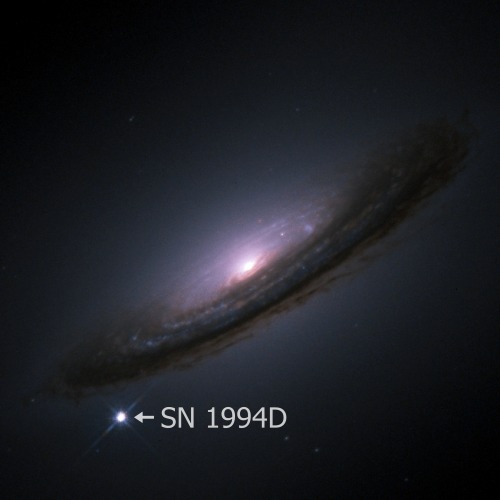
Neutron Stars
If the collapsing stellar core at the center of a supernova contains between about 1.4 and 3 solar masses, the collapse continues until electrons and protons combine to form neutrons, producing a neutron star. Neutron stars are incredibly dense - similar to the density of an atomic nucleus. Because it contains so much mass packed into such a small volume, the gravitation at the surface of a neutron star is immense.
Neutron stars also have powerful magnetic fields which can accelerate atomic particles around its magnetic poles producing powerful beams of radiation. Those beams sweep around like massive searchlight beams as the star rotates. If such a beam is oriented so that it periodically points toward the Earth, we observe it as regular pulses of radiation that occur whenever the magnetic pole sweeps past the line of sight. In this case, the neutron star is known as a pulsar.

Black Holes
If the collapsed stellar core is larger than three solar masses, it collapses completely to form a black hole: an infinitely dense object whose gravity is so strong that nothing can escape its immediate proximity, not even light. Since photons are what our instruments are designed to see, black holes can only be detected indirectly. Indirect observations are possible because the gravitational field of a black hole is so powerful that any nearby material - often the outer layers of a companion star - is caught up and dragged in. As matter spirals into a black hole, it forms a disk that is heated to enormous temperatures, emitting copious quantities of X-rays and Gamma-rays that indicate the presence of the underlying hidden companion.

From the Remains, New Stars Arise
The dust and debris left behind by novae and supernovae eventually blend with the surrounding interstellar gas and dust, enriching it with the heavy elements and chemical compounds produced during stellar death. Eventually, those materials are recycled, providing the building blocks for a new generation of stars and accompanying planetary systems.

Credit and reference: science.nasa.gov
image credit: ESO, NASA, ESA, Hubble

Dusty Stars Of Orion
Voyager: The Golden Record
It’s the 1970s, and we’re about to send two spacecraft (Voyager 1 & 2) into space. These two spacecraft will eventually leave our solar system and become the most distant man-made objects…ever. How can we leave our mark on them in the case that other spacefarers find them in the distant future?
The Golden Record.

We placed an ambitious message aboard Voyager 1 and 2, a kind of time capsule, intended to communicate a story of our world to extraterrestrials. The Voyager message is carried by a phonograph record, a 12-inch gold-plated copper disk containing sounds and images selected to portray the diversity of life and culture on Earth.
The Golden Record Cover
The outward facing cover of the golden record carries instructions in case it is ever found. Detailing to its discoverers how to decipher its meaning.
In the upper left-hand corner is an easily recognized drawing of the phonograph record and the stylus carried with it. The stylus is in the correct position to play the record from the beginning. Written around it in binary arithmetic is the correct time of one rotation of the record. The drawing indicates that the record should be played from the outside in.

The information in the upper right-hand portion of the cover is designed to show how the pictures contained on the record are to be constructed from the recorded signals. The top drawing shows the typical signal that occurs at the start of the picture. The picture is made from this signal, which traces the picture as a series of vertical lines, similar to ordinary television. Immediately below shows how these lines are to be drawn vertically, with staggered “interlace” to give the correct picture rendition. Below that is a drawing of an entire picture raster, showing that there are 52 vertical lines in a complete picture.

Immediately below this is a replica of the first picture on the record to permit the recipients to verify that they are decoding the signals correctly. A circle was used in this picture to ensure that the recipients use the correct ratio of horizontal to vertical height in picture reconstruction.

The drawing in the lower left-hand corner of the cover is the pulsar map previously sent as part of the plaques on Pioneers 10 and 11. It shows the location of the solar system with respect to 14 pulsars, whose precise periods are given.

The drawing containing two circles in the lower right-hand corner is a drawing of the hydrogen atom in its two lowest states, with a connecting line and digit 1 to indicate that the time interval associated with the transition from one state to the other is to be used as the fundamental time scale, both for the time given on the cover and in the decoded pictures.
The Contents
The contents of the record were selected for NASA by a committee chaired by Carl Sagan of Cornell University and his associates.

They assembled 115 images and a variety of natural sounds, such as those made by surf, wind and thunder, birds, whales and other animals. To this, they added musical selections from different cultures and eras, and spoken greetings from Earth-people in fifty-five languages, and printed messages from President Carter and U.N. Secretary General Waldheim.

Listen to some of the sounds of the Golden Record on our Soundcloud page:
Golden Record: Greetings to the Universe
Golden Record: Sounds of Earth

Songs from Chuck Berry’s “Johnny B. Goode,” to Beethoven’s Fifth Symphony are included on the golden record. For a complete list of songs, visit: https://voyager.jpl.nasa.gov/golden-record/whats-on-the-record/music/

The 115 images included on the record, encoded in analog form, range from mathematical definitions to humans from around the globe. See the images here: https://voyager.jpl.nasa.gov/golden-record/whats-on-the-record/images/
Making the Golden Record
Many people were instrumental in the design, development and manufacturing of the golden record.

Blank records were provided by the Pyral S.A. of Creteil, France. CBS Records contracted the JVC Cutting Center in Boulder, CO to cut the lacquer masters which were then sent to the James G. Lee Record Processing center in Gardena, CA to cut and gold plate eight Voyager records.

The record is constructed of gold-plated copper and is 12 inches in diameter. The record’s cover is aluminum and electroplated upon it is an ultra-pure sample of the isotope uranium-238. Uranium-238 has a half-life of 4.468 billion years.
Learn more about the golden record HERE.
Make sure to follow us on Tumblr for your regular dose of space: http://nasa.tumblr.com

Great Basin National Park in Nevada is one of the darkest spots in the United States. What better time to appreciate this park’s clear night sky, then on International Day of Clean Air? Good air quality coupled with a lack of light pollution give visitors majestic starry views of Wheeler Peak. On clear, moonless nights at Great Basin, thousands of stars, numerous planets, star clusters, meteors, man-made satellites, the Andromeda Galaxy, and the Milky Way can be seen with the naked eye. The area boasts some of the darkest night skies left in the country. Low humidity, good air quality, and minimal light pollution, combined with high elevation, create a unique window to the universe. Photo by John Vermette (sharetheexperience.org). Photo description: A bright Milky Way and night sky filled with stars light up the mountains below.
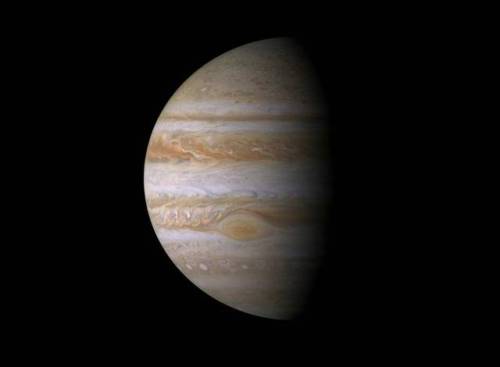
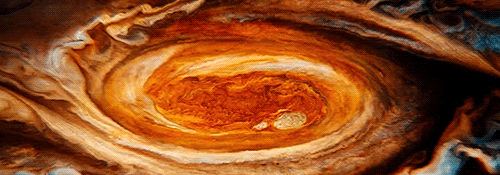
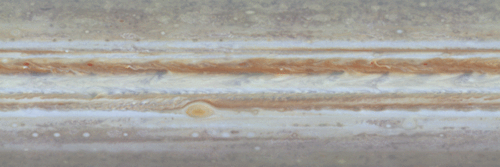
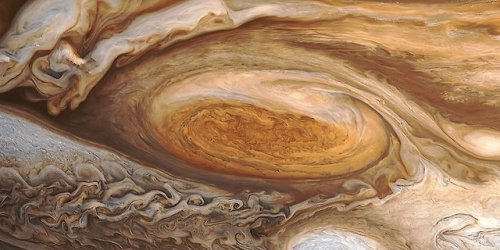
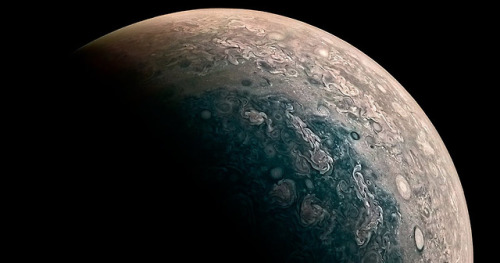
Jupiter is perpetually covered with clouds composed of ammonia crystals and possibly ammonium hydrosulfide. The clouds are located in the tropopause and are arranged into bands of different latitudes, known as tropical regions. These are sub-divided into lighter-hued zones and darker belts. The interactions of these conflicting circulation patterns cause storms and turbulence. Wind speeds of 100 m/s (360 km/h) are common in zonal jets. The zones have been observed to vary in width, color and intensity from year to year, but they have remained sufficiently stable for scientists to give them identifying designations.
The cloud layer is only about 50 km (31 mi) deep, and consists of at least two decks of clouds: a thick lower deck and a thin clearer region. There may also be a thin layer of water clouds underlying the ammonia layer. Supporting the idea of water clouds are the flashes of lightning detected in the atmosphere of Jupiter. These electrical discharges can be up to a thousand times as powerful as lightning on Earth. The water clouds are assumed to generate thunderstorms in the same way as terrestrial thunderstorms, driven by the heat rising from the interior.
source
TOP 10 PREHISTORIC OCEAN PREDATORS

10. ANOMALOCARIS (~ 525 Ma) This one metre long invertebrate surely deserves to be included on the list, being one of the first complex oceanic predators to ever have existed. Anomalocaris stalked the Cambrian oceans, viewing the world with a deadly new evolutionary innovation - eyes. Complex eyes allowed this creature to storm its way to the top of the food chain, and with powerful appendages covered in spines it had no trouble devouring prey with tough carapaces. Whilst Anomalocaris is dwarfed by the other contenders on this list, it was still over 10 times larger than any other animal of its time.

9. KRONOSAURUS (125-99 Ma) Kronosaurus, a Cretaceous mosasaur, is named after the Greek titan, Cronus. Its name is well deserved as this ancient beast was a remarkably powerful being. Kronosaurus could reach up to 10 metres long and had a mouth full of sharp, conical teeth. Unlike most other mosasaurs its tail was relatively short, however, evidence shows that Kronosaurus has immensely powerful fins and a pectoral girdle making it an impressive swimmer and hunter.

8. HELICOPRION (290-250 Ma) Helicoprion has astounded scientists since its discovery over 100 years ago. It is iconic for its bizarre spiral of teeth, there are still debates on where exactly these teeth where on the shark with proposals stating they were inside the mouth, on the tip of the tail, the dorsal fin or hanging under the jaw. The most commonly accepted location of the teeth is inside the lower jaw enabling Helicoprion to cleanly slice its prey into pieces.

7. XIPHACTINUS (~110-70 Ma) Xiphactinus was an extraordinary fish that lived during the Cretaceous. It was an esteemed predator that could reach an incredible 6 metres in length and specimens are renowned for their stunning preservation. One such example was 4 metres long and found with another exceptionally well preserved fish just short of 2 metres inside it implying that this particular Xiphactinus individual died shortly after its last feast. Xiphactinus had immensely sharp, slim teeth and an unmistakable underbite which was a possible aid when snaring creatures from below.

6. TYLOSAURUS (86-75 Ma) Tylosaurus is considered a mosasaur and was a vivacious predator all be it smaller than its relative Mosasaurus. Tylosaurus could reach up to 15 metres in length and was one of the apex predators of its day. Fossilised stomach contents of Tylosaurus contain fish, sharks, turtles and other marine reptiles. Despite having an impressive set of teeth, the frontal areas of the jaws exhibit a large reduction in tooth size as well as a more heavily reinforced snout in comparison to other mosasaurs suggesting that Tylosaurus may have rammed into victims with immense force damaging prey internally.

5. MOSASAURUS (70-66 Ma) The mosasaurs ruled the Cretaceous oceans and Mosasaurus was no exception. It could reach up to 17 metres long, longer than most other mosasaurs. Mosasaurus had a strong jaw packed with numerous conical teeth, bite marks of which have been found in huge prehistoric turtles and ammonites suggesting that Mosasaurus was a formidable hunter capable of catching large prey. Mosasaurus was a profound swimmer with strong paddle-like limbs and a huge tail capable of rapidly accelerating the animal when required.

4. DUNKLEOSTEUS (382-358 Ma) Dunkleosteus terrorised the oceans around 370 million years ago and was part of a dynasty known as the placoderm fish (meaning armoured). Dunkleosteus could reach a whopping 6-10 metres in length and probably weighed over a ton. The skull was made up of huge, solid bony plates giving unrivalled protection allowing them to dominate the oceans. Placoderm fish were some of the first organisms to have a mobile jaw, as can be seen in Dunkleosteus’ impressive shearing plates which were used to slice cleanly through prey. Despite an revolutionary jaw, Dunkleosteus could not chew and several fossilised regurgitated remains of its meals have been found that the giant fish simply could not stomach.

3. DAKOSAURUS (157-137 Ma) Dakosaurus was the largest of a group of marine reptiles that were distant relatives of crocodiles. Dakosaurus could reach up to 5 metres long and had a streamlined body with large paddle-like fins and a long muscular tail implying that is was a very efficient swimmer. The diet of Dakosaurus consisted mostly of fish. The teeth of Dakosaurus are lateromedially compressed and serrated which is a similar morphology to modern killer whales indicating that Dakosaurus was an apex predator of the Jurassic oceans. Skull fenestrae provides evidence that Dakosaurus had very large adductor muscles (which are responsible for the jaw closing) and so it was certainly capable of a forceful bite.

2. LIOPLEURODON (160-155 Ma) Liopleurodon stormed the Jurassic oceans, its huge 7 metre long frame effortlessly cruised through the water. The skull itself could reach a massive 1.5 metres long with a jaw that was packed with teeth up to 10cm long and was capable of an immense bone-crushing force. Liopleurodon was a remarkable hunter with the ability to swim with its nostrils open and so could use its powerful sense of smell to track prey from afar, much like sharks do. Liopleurodon most likely had good camouflage such as a lighter underside and a darker topside so it would blend in with the water to prey above and below.

1. MEGALODON (~16-2.6 Ma) Megalodon rightfully deserves the top position of the greatest prehistoric ocean predators, ruling the seas for an incredible 14 million years. Megalodon has been estimated to reach up to 18 metres in length and weighing over 40 tonnes. Megalodon is known for its huge 6 inch teeth which were serrated on both sides for an efficient slicing action. Fossils of Megalodon’s prey have also been found, the shark appeared to have adapted its hunting tactics for different sized prey; for smaller prey they would just use their bone crushing bite to pulverise internal organs, but for larger prey they would bite or rip flippers off of creatures to immobilise them and then go in for the kill. The exact bite force of Megalodon has been estimated at around 110,000 N which was more than enough to shatter even the most robust bones. The hunting methods of Megalodon will unfortunately remain a mystery but it was been hypothesised that they swam at great depths and used short bursts of speed to swim up and tear into their preys vulnerable underbelly. Sharks have existed for over 420 million years and still continue to be some of the most successful predators alive, Megalodon is a perfect example of how deadly they can be.
-
 space-moms-my-wife reblogged this · 2 years ago
space-moms-my-wife reblogged this · 2 years ago -
 smokeonthebreeze liked this · 3 years ago
smokeonthebreeze liked this · 3 years ago -
 hummingmoonn liked this · 3 years ago
hummingmoonn liked this · 3 years ago -
 asheav9n liked this · 3 years ago
asheav9n liked this · 3 years ago -
 suncircler liked this · 3 years ago
suncircler liked this · 3 years ago -
 neoboreal reblogged this · 3 years ago
neoboreal reblogged this · 3 years ago -
 iva-teazel liked this · 3 years ago
iva-teazel liked this · 3 years ago -
 lilithfatale reblogged this · 3 years ago
lilithfatale reblogged this · 3 years ago -
 lilithfatale liked this · 3 years ago
lilithfatale liked this · 3 years ago -
 rnangopantsu reblogged this · 3 years ago
rnangopantsu reblogged this · 3 years ago -
 rnangopantsu liked this · 3 years ago
rnangopantsu liked this · 3 years ago -
 haml3t reblogged this · 3 years ago
haml3t reblogged this · 3 years ago -
 mavieemav liked this · 3 years ago
mavieemav liked this · 3 years ago -
 motopvpi reblogged this · 3 years ago
motopvpi reblogged this · 3 years ago -
 ateloven reblogged this · 3 years ago
ateloven reblogged this · 3 years ago -
 jasminerice liked this · 3 years ago
jasminerice liked this · 3 years ago -
 drashnar16 liked this · 3 years ago
drashnar16 liked this · 3 years ago -
 sophrosynn liked this · 3 years ago
sophrosynn liked this · 3 years ago -
 paranoid4prof3t liked this · 3 years ago
paranoid4prof3t liked this · 3 years ago -
 nomindreader liked this · 3 years ago
nomindreader liked this · 3 years ago -
 mountainoflove reblogged this · 3 years ago
mountainoflove reblogged this · 3 years ago -
 gnostix1 liked this · 3 years ago
gnostix1 liked this · 3 years ago -
 eclectic-tidalwave reblogged this · 3 years ago
eclectic-tidalwave reblogged this · 3 years ago -
 eclectic-tidalwave liked this · 3 years ago
eclectic-tidalwave liked this · 3 years ago -
 wanderlland reblogged this · 3 years ago
wanderlland reblogged this · 3 years ago -
 retalhoserelapsos reblogged this · 3 years ago
retalhoserelapsos reblogged this · 3 years ago -
 retalhoserelapsos liked this · 3 years ago
retalhoserelapsos liked this · 3 years ago -
 icedhnyamericano liked this · 3 years ago
icedhnyamericano liked this · 3 years ago -
 satvrnales liked this · 3 years ago
satvrnales liked this · 3 years ago -
 ippokampos liked this · 3 years ago
ippokampos liked this · 3 years ago -
 thecreatorr reblogged this · 3 years ago
thecreatorr reblogged this · 3 years ago -
 gkriniazw-poly liked this · 3 years ago
gkriniazw-poly liked this · 3 years ago -
 ruhumdakisaklicennet liked this · 3 years ago
ruhumdakisaklicennet liked this · 3 years ago -
 blue-sky-full-of-stars reblogged this · 3 years ago
blue-sky-full-of-stars reblogged this · 3 years ago -
 whateverimareader liked this · 3 years ago
whateverimareader liked this · 3 years ago -
 mariantono reblogged this · 3 years ago
mariantono reblogged this · 3 years ago -
 mariantono liked this · 3 years ago
mariantono liked this · 3 years ago

Amateur astronomer, owns a telescope. This is a side blog to satiate my science-y cravings! I haven't yet mustered the courage to put up my personal astro-stuff here. Main blog : @an-abyss-called-life
212 posts